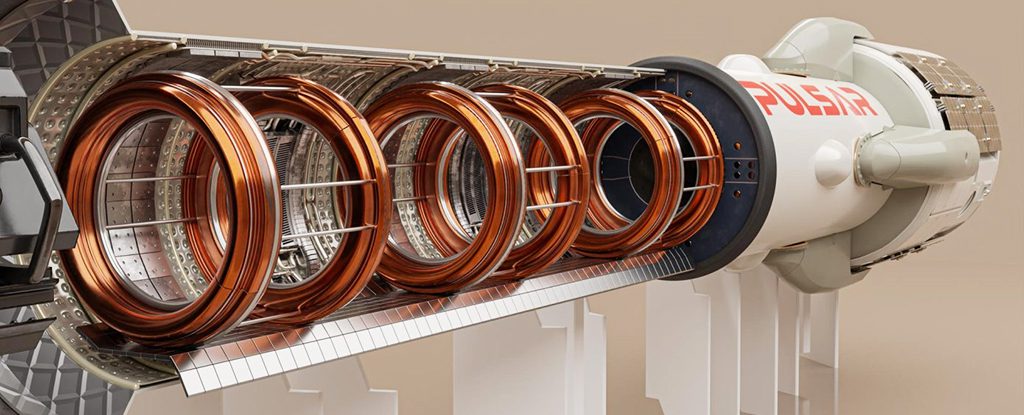In a groundbreaking move, the world’s largest nuclear fusion rocket engine has begun construction in the UK, promising to redefine space travel. Pioneered by Pulsar Fusion, this audacious project aims to harness the power of the sun, the same reactions that could halve the voyage to Mars, or make Saturn’s moons a mere two-year journey away. However, the challenge remains: can we contain ultra-hot plasma within an electromagnetic field? The outcome may reshape our understanding of space travel, making what seems like a far-off science fiction dream, a tangible reality.
The undertaking is a monumental one. Pulsar Fusion, based in Bletchley, is collaborating with Princeton Satellite Systems in the US, with the daunting task of mastering an environment hotter than the sun. Within an 8-meter long chamber scheduled to begin operations in 2027, temperatures of several hundred million degrees will be attained, creating a hotbed of innovation and intense scrutiny.
At the heart of this mammoth task is nuclear fusion propulsion, a technology defined by an ultra-hot plasma contained within an electromagnetic field. This plasma behaves unpredictably, akin to a wild weather system, making it a monumental challenge to tame and control. This unpredictability has led to naysayers questioning the project’s viability. “The difficulty is learning how to hold and confine the super-hot plasma within an electromagnetic field,” commented James Lambert, CFO of Pulsar Fusion, expressing the challenge posed by the task at hand.
However, groundbreaking techniques and cutting-edge technology may provide the solution to this problem. Pulsar Fusion is utilizing machine learning algorithms, which could help map the unpredictable behavior of the plasma, bringing an unprecedented level of precision to the project. This collaboration of rocket science and artificial intelligence provides hope that the unpredictability of the plasma may be overcome.
Yet, the project extends beyond just taming the plasma. The fusion rocket engine under construction is a Direct Fusion Drive (DFD), a type of engine where the charged particles create thrust directly rather than being converted into electricity. This approach is significantly more efficient than other alternatives, and as it is powered by atomic isotopes, it doesn’t require a substantial fuel payload. This marriage of efficiency and cutting-edge science is what makes the fusion rocket a compelling proposition.
The potential benefits of this technology are far-reaching. Not only does it promise to revolutionize space travel, making distant planets more accessible and significantly reducing travel times, but it also promises to provide almost unlimited, clean energy. If successful, the project could propel humanity into a new era of exploration and energy production, a testament to the unrelenting drive of human ingenuity.
Pulsar Fusion’s CEO, Richard Dinan, confidently poses the question, “Can humanity do fusion?” He firmly believes in the potential and inevitability of fusion propulsion. “If we can – and we can – then fusion propulsion is totally inevitable. It’s irresistible to the human evolution of space,” Dinan said. His confidence, backed by the considerable strides made by his team, is both encouraging and exciting.
However, it’s worth noting that the application of fusion technology might be demonstrated in space first, where conditions such as the absence of atmosphere and the ultra-cold temperatures are more conducive to reactions. The outer space environment could prove the perfect testing ground, ensuring the technology is ready and safe for deployment back on Earth.
Despite the considerable challenges, there is no denying the immense potential this project carries. If Pulsar Fusion and Princeton Satellite Systems can achieve what they’ve set out to do, then we are on the brink of a significant leap forward. A successful nuclear fusion rocket engine will not only make space exploration more accessible and feasible but could also have significant implications for energy production here on Earth.
The world watches as the largest nuclear fusion rocket engine’s construction is underway, carrying the weight of our ambitions for space travel and the future of energy. Amid the exhilarating potential and daunting challenges, the question remains: can we truly harness the power of the sun? If we can, the implications are vast, promising a revolution in space exploration and clean energy. As humanity takes one giant leap closer to this thrilling reality, we stand at the precipice of a new era, eagerly awaiting the transformative power of nuclear fusion. The journey has only just begun, and the possibilities are boundless.



